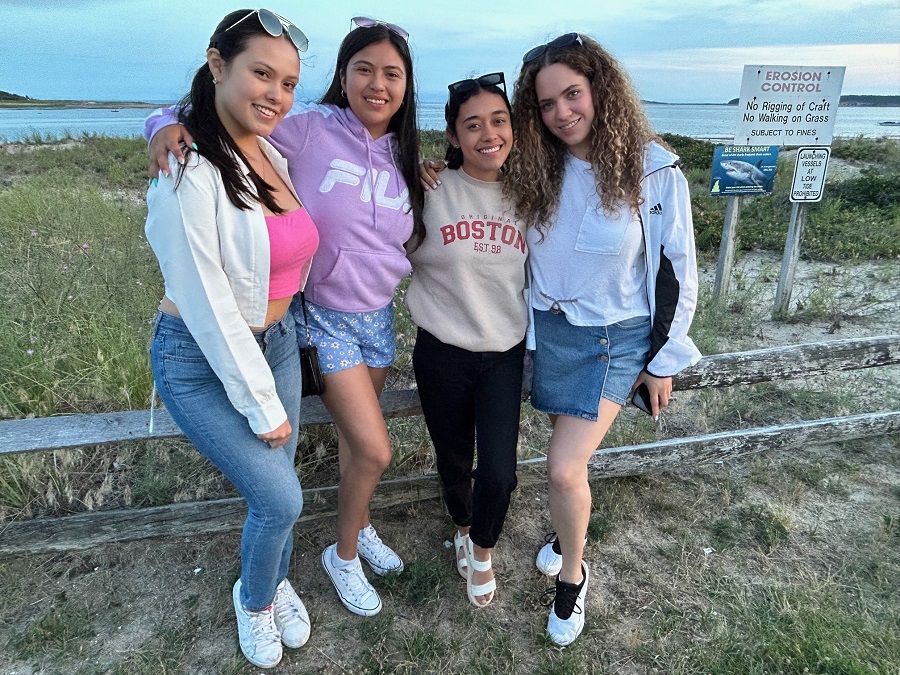WELLFLEET — The decades-long fight to unite local stakeholders behind the restoration of the Herring River — the largest salt marsh restoration project in Massachusetts history — has created ripples as far as 3,000 miles away, where in the city of Patzcuaro, Mexico four university students are trying to save a beloved lake from its gloomy prognosis.
Valeria Aguilar, Molly Peñaloza, Alejandra Garcia, and Ireri Servin visited Wellfleet last week to learn how people here eventually came together to agree on the environmental upside of the project.
“We are here because we want to learn how Wellfleet organized people under a common plan,” said Aguilar. “That’s our biggest problem in our community — people aren’t coming together.”

Lake Patzcuaro is in the Mexican state of Michoacán, where four municipalities rely on its health for their economic and cultural well-being. In the last 30 years, the lake has lost 40 percent of its water, shrinking from 117 square miles to 50 square miles, according to the students. They say they have another 5 to 20 years before the lake disappears completely.
Like Wellfleet’s, Patzcuaro’s economy relies on tourism and fishing, two industries precariously defined by their proximity to natural resources. But the ailments that threaten the future of the Herring River and Lake Patzcuaro are completely different, said Jane Wholey, who works with the students at Campamento de la Paz, a children’s summer camp in Patzcuaro dedicated to social change, where the four young women are interns. Wholey organized their 10-day visit with help from a longtime Wellfleet friend, Kathrine Letourneau, and sponsorship by the National Park Service. The slow gears of community organizing are what bring the two stories together.
Unlike the Herring River, which has been degraded by the presence of a dike that was constructed in 1909 to block tidal flow, the pollution that plagues Lake Patzcuaro is the result of many factors. The deforestation of surrounding areas leads to increased runoff of fertilizers and pesticides from nearby avocado farms. Many of those fertilizers, Aguilar said, are not well regulated in Mexico; the same chemicals are illegal to use in the United States.

“When you see an avocado that is exported, you might see a delicious fruit, but I see our water, our forest, our soil, our weather, and our blood,” Aguilar said during a presentation on Lake Patzcuaro the students gave at the Salt Pond Visitor Center on July 12.
The lake also suffers from poor management of garbage and wastewater disposal, Garcia said. The local government’s plan to build 11 sewage treatment plants is far from complete, and without functioning plants, untreated wastewater goes directly into the lake, she said, harming native fish and plant species.
“People know that the lake is dying, but no one knows what to do about it,” said Garcia.
The students met with representatives from the Friends of Herring River, Wellfleet town officials, and National Seashore staff to seek advice and strategize.
“The key is to listen,” said Aguilar, relaying advice the students received from Friends of Herring River board chair Dale Rheault. “Another key is to be transparent with information,” Aguilar said. And, she added, “We learned the term ‘baby steps.’ ”
“Knowledge is power,” Rheault told them. “There is a fear of the unknown, so presenting people with accurate information is the most important thing.”
It took 50 years, if you count discussions begun in the 1960s, for the Herring River restoration to get underway. A town-Seashore agreement on feasibility studies was formalized in 2005, and the project has now attracted almost $70 million in grant aid. Construction of a bridge to replace the dike has begun on Chequessett Neck Road, and the clearing of dead vegetation in Duck Harbor is halfway done.
The students plan to present their findings to Patzcuaro Mayor Julio Alberto Arreola Vásquez and spread the word through their work as interns for Campamento de la Paz.
“We want to show people,” said Peñaloza. “It’s our lake, not just my lake, or her lake.”
“We have a lot of work to do,” Aguilar said.



